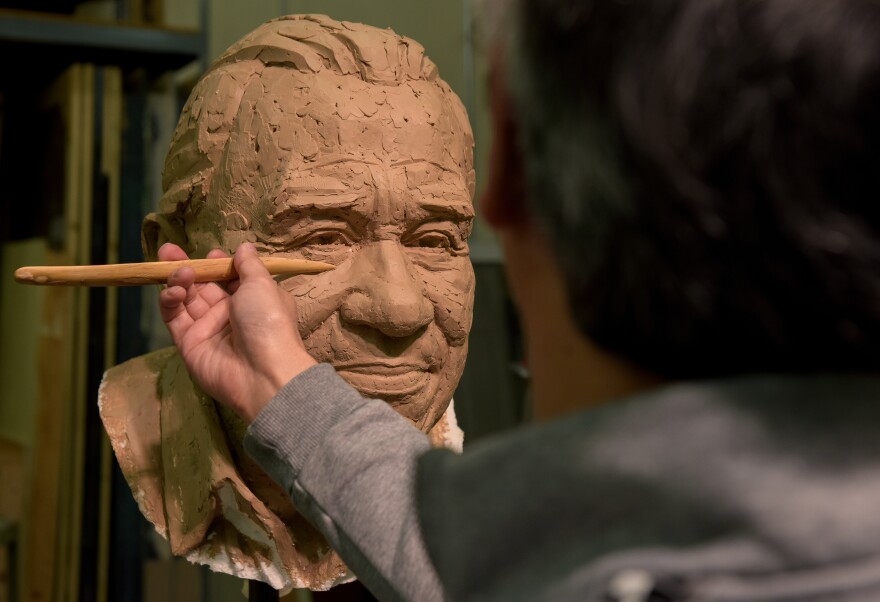Washington state is sending a statue of an Indigenous activist it arrested more than 50 times to the Halls of Congress.
The statue of Billy Frank Jr. will be the first contemporary depiction of an Indigenous person in National Statuary Hall, since Oklahoma put a statue of movie star Will Rogers there in 1939.
Frank is wearing jeans, a button-down shirt and a bolo tie. His hair is in a ponytail and he’s got a big smile on his face.
Artist Haiying Wu molded in clay small details like wrinkles on Frank’s face.
“You know, kind of like a grandpa figure,” Wu said.
Frank is sitting down on a piece of driftwood near the Nisqually River. Below his cowboy boots, salmon are jumping out of the water. Frank fought his whole life to protect the fish, which are a mainstay for the diets and cultural practices of the Nisqually people.
Wu said he based the design of the statue on numerous photos of Frank, most of which are of him protesting when he was younger.

"He's been standing up, you know, fighting all his life, but he's gone," Wu said. "And to commemorate him, I think it'd be better to put him in a resting place."
The statue of Frank in a relaxed pose will be cast in bronze and sent to National Statuary Hall next year. It’ll stand alongside other historical figures — inventors, former Congress people and the country’s founding fathers.
Jami Powell, curator of Indigenous art at Hood Museum in New Hampshire, said it’s different from other Native American figures in the hall.
“It disrupts this idea of Native people as stoic," she said. "But also celebrates the important legacy of Billy Frank and all of his accomplishments.”
Powell said Native people have recently had more of a say in how they're represented in public art.
“There’s now growing opportunity for us to tell our own stories," she said. "And to work with non-Native people outside of our communities — with allies — to kind of tell these more complicated stories as well.”
Each state has two statues in the hall to honor notable people in its history.
The Frank statue will replace Washington’s statue of pioneer and Protestant missionary Marcus Whitman, which was installed in 1953. Whitman led wagon trains of white settlers west to Washington in the 1800s. The “great migration” also brought disease and devastated Native communities.
So, the state decided to swap out the Whitman statue in 2021.
Josh Reid, history and American Indian studies professor at the University of Washington, said that’s a notable shift.
“It’s showing the state’s support and recognition, I think, for treaty rights," he said. "And it’s showing, the kind of support for salmon fisheries.”
Frank's statue will stand near Nebraska’s statue of Chief Standing Bear of the Ponca Tribe. He’s known for a court ruling in 1879 that recognized Native Americans as “persons” under the U.S. Constitution.

Frank’s son, Willie Frank III, said that the placement is fitting. His dad also fought for the rights of Native Americans in his time.
“One is ready to go to war, Chief Standing Bear, still very stoic and posing," he said. "Then you'll have my father sitting there, who went to war plenty of times and survived it — but he's just cool, as calm as can be, sitting along the Nisqually River waiting for the fish to run.”
Billy Frank Jr. was only 14 years old the first time he was arrested under a state law that prohibited net fishing by Indians in off-reservation areas. But a treaty that had taken land away from tribes, also gave them the right to fish in their “usual and accustomed places.”
Willie is pleased that all that his dad fought for – the river and the salmon – is incorporated into the statue. He said the jeans were a must.
“Even the ponytail on the back and like his cowboy boots — and just everything about it is my dad,” he said.

Willie and his older brother still fish the Nisqually River today.
“This is the area right here where my father, our family, were arrested many times for exercising their treaty right,” he said while standing along the river on a recent rainy day.
Those arrests culminated in the Boldt Decision just over 50 years ago. The ruling affirmed tribal fishing rights, entitling Native Americans to half the salmon catch in the state. It also forced the federal government to keep its promises to tribes and made tribes equal partners with the state in salmon management and restoration.
The river is laced with memories for the Frank family.
“A fish would hit the net, and he'd damn near jump in after it,” Willie said.
He said his father loved being here on the river.
“Didn't matter how big the fish was... Didn't matter if we were making money on the fish — It was just about catching that fish with his boys,” Willie said.
It’s this Frank — the relentless activist and fisherman — who’s being memorialized as a person who helped shape the country.







